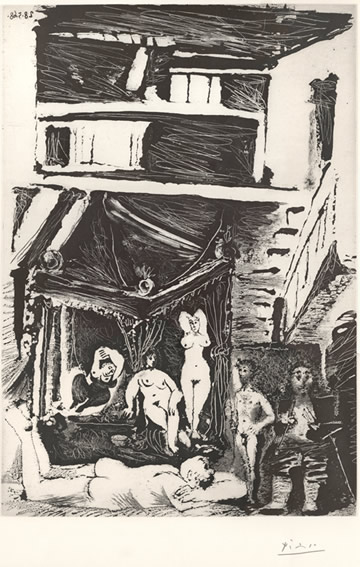 This original
sugar-lift aquatint, Untitled
(Old Man thinking of his youth) (Vieil Homme Songeant À Sa Vie:
Jeunesse Galante,
Age Mar de Peintre Célèbre, De Uvre Creie Dans Un Taudis
et Trônant Maintenant Sousin Dais),
1968 is
plate 123 from the 347
Series. This etching was
signed by Picasso and is number 1 of 17 artist proofs. An edition
of
50 also exists.
This original
sugar-lift aquatint, Untitled
(Old Man thinking of his youth) (Vieil Homme Songeant À Sa Vie:
Jeunesse Galante,
Age Mar de Peintre Célèbre, De Uvre Creie Dans Un Taudis
et Trônant Maintenant Sousin Dais),
1968 is
plate 123 from the 347
Series. This etching was
signed by Picasso and is number 1 of 17 artist proofs. An edition
of
50 also exists.
The Marina Picasso Collection oval stamp is on the back side of this
etching. Marina is Picasso's grand-daughter, born in 1951 to Olga
and Picasso's son Paulo (Paul). She now makes her home in
New York, Geneva, and her grandfather's house in Cannes. In her
collection remain about 400 Picasso paintings and over 7,000 sketches,
drawings, and sculptures. This etching is an artist proof from
her collection.
Between March 16 and October 5, 1968, Picasso created 347 etchings and
aquatints (some days completing 2 or 3 etching plates), an astonishing
outpouring of energy when Picasso was 86 years old. The series
began shortly after the
death of his companion and friend, Catalan poet Jaime Sabartés
(1881-1968). Picasso dedicated
a set of proofs in his memory.
In this large group of images Picasso references earlier subjects such
as French writer Honoré Balzac (1799-1850) , Rembrandt
(1606-1669), El Greco (1541-1614) and also his family -- parents, wives
and mistresses -- who often appear as performers, sometimes set in
circus scenes.
This
image is a portrayal of the now old artist reflecting on the passage of
time since his youth from the bordellos of Paris in the early 1900s to
his fame as an artist more than 60 years later.
With irony and ribald humor Picasso reviewed his life in this series,
his failing powers and his place in history. In fact, Picasso is
often observed in many of the 347
Series images as voyeur in these
images of fantasy and imagination.
The 347 Series
was printed in collaboration with brothers Piero (1934-2001) and Aldo
Crommelynck who, in 1963, set up a studio in Mougins when Picasso was
82 years old. Picasso's prolific production relied on the
absolute trust he had between himself and the master
engravers. The series was exhibited and published by the Galerie Louise Leiris
(Paris) in late 1968 and 1969. The etchings were not given titles
by Picasso as the artist usually had no use for them.
This
etching is
an excellent example of Picasso's sugar-lift aquatint technique of
printing. The advantage of sugar-lift aquatint as a printmaking
method is its ability to achieve tonal qualities and a painting-like
quality where etching alone more normally is very linear.
Picasso began by painting his metal etching plate with a solution of
sugar and black ink. The entire plate is then coated with an
acid-resistant varnish. The plate is then immersed in warm water
which causes the sugar to melt, lifting the varnish ("sugar-lift") and
exposing the metal plate in the areas that were originally "painted".
The artist would then powder or paint acid-resistant particles over
certain areas of the metal plate. The aquatint particles are then
fused to the plate with heat. When the plate is immersed in a
bath of acid the particles prevent the surface from being eaten away
resulting in a tiny polka dot-like texture that creates the illusion of
tonal range.
Picasso was famous for the sugar-lift and aquatint technique in several
of his 347 Series
etchings, this being one of the best examples.
 This original
sugar-lift aquatint,
This original
sugar-lift aquatint,  This original
sugar-lift aquatint, Untitled
(Old Man thinking of his youth) (Vieil Homme Songeant À Sa Vie:
Jeunesse Galante,
Age Mar de Peintre Célèbre, De Uvre Creie Dans Un Taudis
et Trônant Maintenant Sousin Dais),
1968 is
plate 123 from the 347
Series. This etching was
signed by Picasso and is number 1 of 17 artist proofs. An edition
of
50 also exists.
This original
sugar-lift aquatint, Untitled
(Old Man thinking of his youth) (Vieil Homme Songeant À Sa Vie:
Jeunesse Galante,
Age Mar de Peintre Célèbre, De Uvre Creie Dans Un Taudis
et Trônant Maintenant Sousin Dais),
1968 is
plate 123 from the 347
Series. This etching was
signed by Picasso and is number 1 of 17 artist proofs. An edition
of
50 also exists.